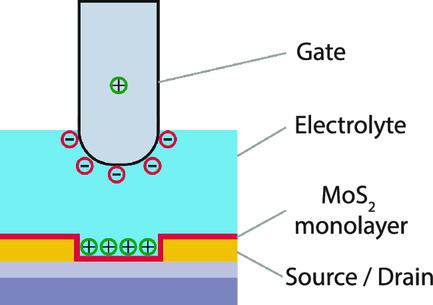当前位置:
X-MOL 学术
›
Phys. Status Solidi. Rapid Res. Lett.
›
论文详情
Our official English website, www.x-mol.net, welcomes your feedback! (Note: you will need to create a separate account there.)
Benchmarking Electrolyte-Gated Monolayer MoS2 Field-Effect Transistors in Aqueous Environments
Physica Status Solidi-Rapid Research Letters ( IF 2.8 ) Pub Date : 2021-06-02 , DOI: 10.1002/pssr.202100147 Daniel Steffen Rühl 1 , Max Heyl 1 , Fabian Gärisch 1 , Sylke Blumstengel 1 , Giovanni Ligorio 1 , Emil J. W. List-Kratochvil 1, 2
Physica Status Solidi-Rapid Research Letters ( IF 2.8 ) Pub Date : 2021-06-02 , DOI: 10.1002/pssr.202100147 Daniel Steffen Rühl 1 , Max Heyl 1 , Fabian Gärisch 1 , Sylke Blumstengel 1 , Giovanni Ligorio 1 , Emil J. W. List-Kratochvil 1, 2
Affiliation

|
Most electrical sensor and biosensor elements require reliable transducing elements to convert small potential changes into easy to read out current signals. Offering inherent signal magnification and being operable in many relevant environments field-effect transistors (FETs) are the element of choice in many cases. In particular, using electrolyte gating, numerous sensors and biosensors have been realized in aqueous environments. Over the past years, electrolyte-gated FETs have been fabricated using a variety of semiconducting materials, including graphene, ZnO, as well as conjugated molecules and polymers. Above all, using conducting polymers top-performing devices have been achieved. Herein, an approach to use a transition metal dichalcogenide (TMDC)-based monolayer device as a transducing element is presented. Using MoS2 monolayers, it is shown that such electrolyte-gated devices may be regarded as very promising transducing elements for sensor and biosensor applications, enabled by their high sensitivity for environmental changes and the possibility of using the naturally occurring sulfur vacancies as grafting points of biorecognition layers. Furthermore, the behavior of such a device under prolonged operation in a dilute biologically relevant electrolyte such as phosphate buffered saline solution (PBS) is reported.
中文翻译:

水环境中电解质门控单层二硫化钼场效应晶体管的基准测试
大多数电传感器和生物传感器元件需要可靠的转换元件来将微小的电位变化转换为易于读出的电流信号。场效应晶体管 (FET) 可提供固有的信号放大率并可在许多相关环境中运行,是许多情况下的首选元件。特别是,使用电解质门控,已经在水性环境中实现了许多传感器和生物传感器。在过去的几年里,电解质门控 FET 已经使用各种半导体材料制造,包括石墨烯、ZnO 以及共轭分子和聚合物。最重要的是,使用导电聚合物已经实现了性能最佳的设备。在此,提出了一种使用基于过渡金属二硫属化物 (TMDC) 的单层器件作为转换元件的方法。使用 MoS2单层,表明这种电解质门控装置可被视为非常有前途的传感器和生物传感器应用的转换元件,因为它们对环境变化具有高灵敏度,并且可以使用天然存在的硫空位作为生物识别层的接枝点. 此外,还报告了这种装置在稀释的生物相关电解质(如磷酸盐缓冲盐水溶液 (PBS))中长时间运行时的行为。
更新日期:2021-06-02
中文翻译:

水环境中电解质门控单层二硫化钼场效应晶体管的基准测试
大多数电传感器和生物传感器元件需要可靠的转换元件来将微小的电位变化转换为易于读出的电流信号。场效应晶体管 (FET) 可提供固有的信号放大率并可在许多相关环境中运行,是许多情况下的首选元件。特别是,使用电解质门控,已经在水性环境中实现了许多传感器和生物传感器。在过去的几年里,电解质门控 FET 已经使用各种半导体材料制造,包括石墨烯、ZnO 以及共轭分子和聚合物。最重要的是,使用导电聚合物已经实现了性能最佳的设备。在此,提出了一种使用基于过渡金属二硫属化物 (TMDC) 的单层器件作为转换元件的方法。使用 MoS2单层,表明这种电解质门控装置可被视为非常有前途的传感器和生物传感器应用的转换元件,因为它们对环境变化具有高灵敏度,并且可以使用天然存在的硫空位作为生物识别层的接枝点. 此外,还报告了这种装置在稀释的生物相关电解质(如磷酸盐缓冲盐水溶液 (PBS))中长时间运行时的行为。


























 京公网安备 11010802027423号
京公网安备 11010802027423号